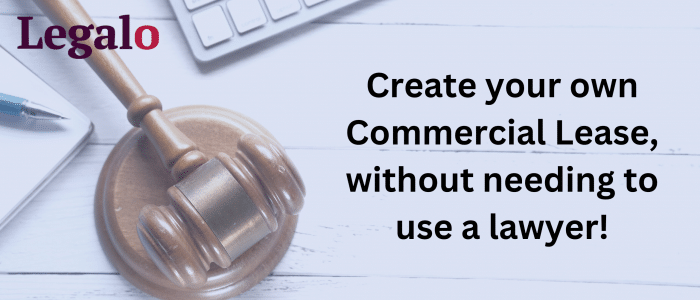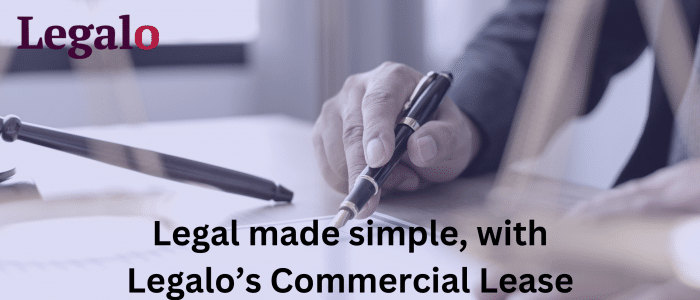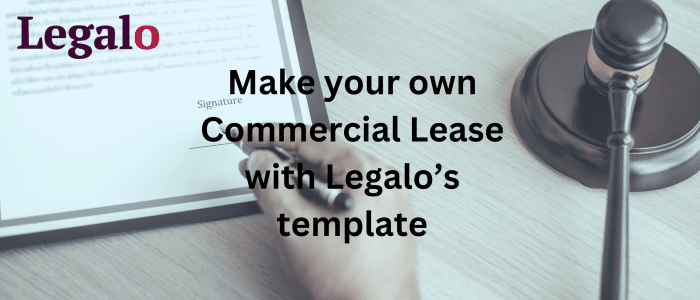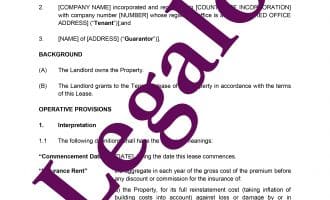Commercial Lease Agreement
Our Commercial Lease Agreement template:
- Simple to edit and complete</li>
- drafted by a UK expert for reliability
- full guidance notes to assist editing
- cost-effective legal peace of mind

How Does It Work?
-
1. Download
-
2. Edit
-
3. Print
-
4. Sign
This is our commercial lease agreement template for leasing business property based in England and Wales. The lease is not suitable for property based in Scotland.
If you are looking for a residential lease or tenancy, then please try our Assured Shorthold Tenancy Agreement template.
We have designed our commercial lease template for use when you want to put in place a straight-forward lease for commercial property. You can easily customise it to suit your individual requirements. This template is suitable for the letting of all types of commercial or business property in England and Wales when letting the whole building as one.
This type of commercial lease agreement puts in place a robust and reliable agreement. It is suitable for both short term and long term letting of commercial property where the parties don’t require a break clause. If you do need a break clause, you can find it here, as a supplement to this commercial lease template.
David, our co-founder and solicitor of over twenty years, drafted the template. This ensures that you can rely on the document being up-to-date and legally comprehensive. Our detailed guidance notes (free with the template) make completing the final lease simple and fast. A copy of the guidance notes are available here: guide to this commercial lease template.
Letting part of a building
Our template is not suitable for letting part of a building, e.g. where there are shared areas. The latter is a more complex situation. For a lease of part, the landlord needs to reserve rights, charge a service charge and there may also be shared access-ways other shared areas and the rights of other tenants to consider. In such a case, you would be better served by taking professional advice from a solicitor. If you do not have one, then do contact us through our Find-A-Solicitor service for a no-obligation recommendation from our panel of experts.

Contracting out of the Landlord & Tenant Act 1954
If you wish to contract out of the provisions of the Landlord & Tenant Act 1954 that permit the tenant to ask for an extension of the lease when it expires, our guide and free declarations and notices assist you in this regard. We include them with this template when you buy it. Virtually all landlords do use this contracting-out process.
Using our Lease Agreement template
You can download this template for a commercial or business lease in Word format once purchased. Then edit it to your own needs quickly.
We provide a full money-back guarantee if you are not happy with your template document for any reason.
Once you have purchased it, you can reuse the template as many times as you want for creating commercial business leases at no further cost. We keep our templates under review to ensure they are up-to-date. When we update a template that you have bought, we will notify you by email and you will get a free updated template.
Don’t use it for letting property located in Scotland. This is because Scottish property law is very different to that of England and Wales.
What is a Lease?
If you have a building you own for business purposes, you will want to let it to a tenant. To do this, you will have to put in place a lease. You have a number of options. The licence to occupy business premises, for example, puts in place a very flexible agreement. However, it does not offer much protection for the landlord, as it is brief.
The tenancy at will is also a brief simple agreement, but neither party to the agreement can tie the other to a long notice period. This may not be ideal in many business letting arrangements.
This commercial lease agreement creates the most robust and formal of the commercial tenancies available.
The cost of our agreement is inexpensive compared to visiting a high street solicitor for the same document. With our free guidance notes, completing the final agreement yourself is easy.
As a standard lease template, the agreement is flexible. You can use it for a wide range of commercial property types. You can use this template agreement for letting office spaces, retail shops, warehouses or other commercial property.
Read our guide to this commercial lease template to get a better feel for the document. It details what you need to do to complete our lease template.
There is an optional clause that you can use to add a Guarantor. This means that, if the tenant is not meeting the rental obligations, the landlord can require the Guarantor to step in and meet them.
Other resources for landlords from Legalo
Click the link to see the full range of commercial property documents we offer.
We also have residential property agreements that would be suitable for use by a landlord of residential properties.

FAQs on the Commercial Lease Template
Below, we have answered the top questions from the Internet on this topic.
How do commercial leases work in the UK?
Commercial leases in the UK are legally binding contracts between a landlord and a business tenant. These leases grant the tenant the right to use a commercial property for business purposes, with the lease duration being short-term or long-term. Short-term leases typically last a few years and long-term leases can extend beyond 50 years. Tenants may be required to pay a premium upfront, along with ongoing rent for the use of the property. Some leases may also include break clauses, allowing either party to terminate the lease before the agreed-upon end date for added flexibility.
How do you draft a commercial lease?
Drafting a commercial lease in the UK involves gathering these key details:
- Identify the parties involved.
- Specify the property’s details, including address and purpose.
- Set the lease duration, rent amount, and payment terms.
- Define responsibilities for maintenance, repairs, and utilities.
- Outline any permitted alterations or improvements.
- Address insurance requirements.
- Include provisions for rent reviews.
- Include terms for terminating the lease.
- Decide on clauses on dispute resolution.
- Comply with legal requirements, such as Landlord and Tenant Act 1954.
The starting point should be getting a great template to put these details into, such as Legalo’s lease.
What are common terms for a commercial lease?
When drafting a commercial lease, it is important to include details on the lease duration, rent amount, payment frequency, maintenance responsibilities, alterations, insurance requirements, rent review provisions, termination clauses, whether a service charge is also payable, and dispute resolution mechanisms. Additionally, clauses related to repairs, subletting, and compliance with UK law, such as the Landlord and Tenant Act 1954, are often included.
Does a commercial lease need to be registered?
In the UK, commercial leases with a duration exceeding seven years must be registered with the Land Registry to be legally valid. Leases for shorter initial terms don’t require registration.
Who drafts a commercial lease?
Commercial leases are often drafted by solicitors or legal professionals representing either the landlord, depending on the negotiated terms. While it is common for the landlord to prepare the initial draft, both parties may negotiate and revise the lease terms once the first draft is ready. Legal expertise is essential to ensure that the lease complies with the law and protects the interests of both parties, and this is something you can get with a Legalo template.
We suggest if the tenant is buying the Legalo lease, that you check with the landlord beforehand to see if our lease will be acceptable to the landlord, as normally the lease is drafted by the landlord.
Do I need a solicitor to draw up a commercial lease?
While it is not legally required to have a solicitor draw up a commercial lease in the UK, it is highly advisable to have your agreement drafted by legal professionals or use a great template like Legalo’s lease. Commercial leases are complex legal documents, and using a solicitor or a sound template ensures that the lease complies with the law, protects your interests, and addresses potential disputes.
How much do solicitors charge for a commercial lease?
Solicitors’ fees for drafting or reviewing a commercial lease in the UK can vary widely depending on factors like complexity, location, and the solicitor’s experience. On average, you can expect to pay anywhere from £1,000 to £5,000 or more if you choose to go this route. However, if you choose to draft your agreement with the help of Legalo’s comprehensive template for just £39.95.
Who pays legal costs for commercial lease?
In the UK, the responsibility for paying legal costs associated with a commercial lease is negotiated between the landlord and tenant. It is common for each party to cover their own legal fees, which is often clarified in the lease agreement terms, but the landlord may include a provision that the tenant covers the landlord’s legal costs as well. Legal cost responsibilities can vary, so it’s essential to carefully decide on these terms prior to the lease negotiations, and specify the position in the heads of terms for the lease to avoid misunderstandings.
What makes a commercial lease valid?
A commercial lease is valid when it meets several key requirements, including mutual agreement between the landlord and tenant, clear identification of the property, specified lease duration, defined rent amount and payment terms, and adherence to relevant legal and regulatory requirements. The parties must properly sign the agreement, to ensure everyone agrees on the terms. Stamp Duty Land Tax may also be due and you need to register the lease if it was for an initial term of 7 years or more.
What is the most used commercial lease?
In the UK, the most commonly used commercial lease is the “Full Repairing and Insuring” (FRI) lease. In an FRI lease, the tenant is responsible for rent, as well as all maintenance, repairs, and insurance costs associated with the property. It places a significant burden on the tenant, making it essential to understand and negotiate the terms carefully. However, the specific type of lease used can vary depending on factors such as:
- the length of the lease (shorter ones are less likely to be full repairing);
- the current state of the premises (if in a poor condition, then they are less likely to be full repairing);
- whether the property is part of a larger unit or a sublet of one;
- the property type; and
- the negotiation between the parties involved.
At the end of an FRI lease, the tenant needs to ensure the property is in a good state of repair throughout when it hands it back to the landlord. This often means new carpets and a repaint inside and out, if applicable. If the tenant has not done any work needed, then the landlord will inspect, assess the costs with a surveyor and send the tenant the bill. This is a claim for dilapidations. It can often run to several tens of thousands of pounds.
What is the minimum term for a commercial lease in the UK?
In the UK, there is no specific statutory minimum term for a commercial lease. You typically negotiate and agree the term between the landlord and tenant based on their specific needs and circumstances. Commercial leases can vary in duration, from short-term agreements, like one year, to long-term leases spanning several years or even a couple of decades. Commonly commercial leases are under 10 years now, although a couple of decades ago they commonly used to be for a term of 21 years. If the lease is for 7 years or more when the landlord first granted it, then you need ot register the lease at the Land Registry:
- with its own leasehold title; and
- also noted on the landlord’s freehold title.
The flexibility to determine the lease term is a matter of negotiation. You should clearly define it in the lease agreement to avoid misunderstandings. However, the statutory right to renew the lease on the same terms when it expires only applies to leases for:
- a fixed term; and
- with a minimum term of 6 months.


